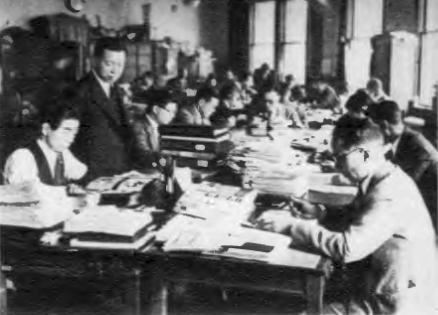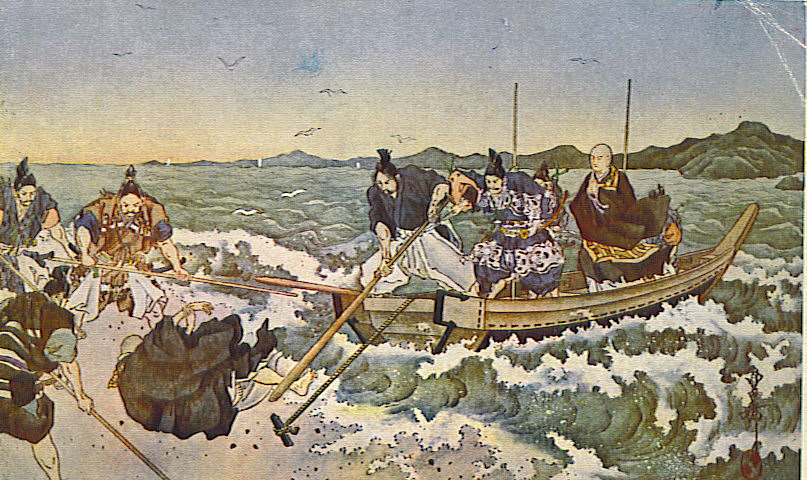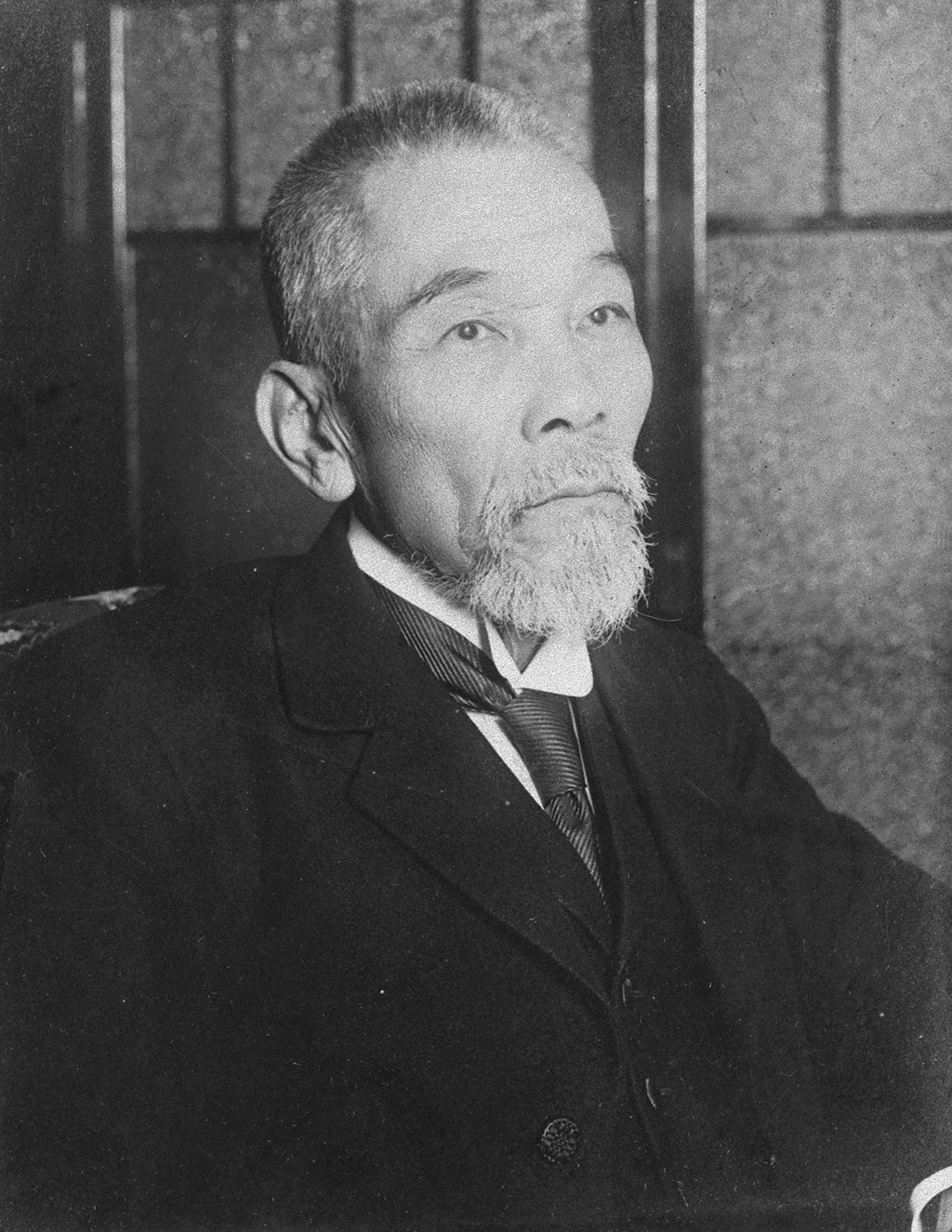|
Jōsei Toda
was a teacher, peace activist and second president of Soka Gakkai from 1951 to 1958. Imprisoned for two years during World War II under violating the Peace Preservation Law and the charge of lèse-majesté from against the war, he emerged from prison intent on rebuilding the Soka Gakkai. He has been described as the architect of the Soka Gakkai, the person chiefly responsible for its existence today. Toda was the disciple of Tsunesaburō Makiguchi and mentor of Daisaku Ikeda, respectively the first and third presidents of the Soka Gakkai. He used the term "human revolution" to embrace Makiguchi's thoughts on the pursuits of education and happiness in life as "inextricably connected in a lifelong journey toward continual self-development." Toda's leadership in building the Soka Gakkai is the theme of Ikeda's 12-volume roman à clef, " The Human Revolution" ("Ningen kakumei") Early life Toda was born in 1900, the eleventh son of a fisherman's family in the coastal village of ... [...More Info...] [...Related Items...] OR: [Wikipedia] [Google] [Baidu] |
Kaga, Ishikawa
is a city located in southwestern Ishikawa Prefecture, Japan. , the city had an estimated population of 67,793 in 29054 households, and a population density of 290 persons per km2. The total area of the city was . Geography Kaga is located in the extreme southwestern corner of Ishikawa Prefecture in the Hokuriku region of Japan and is bordered by the Sea of Japan to the west and Fukui Prefecture to the south. Parts of the coastal areas of the city are within the borders of the Echizen-Kaga Kaigan Quasi-National Park. Neighbouring municipalities *Fukui Prefecture ** Awara ** Katsuyama **Sakai *Ishikawa Prefecture ** Komatsu Climate Kaga has a humid continental climate (Köppen ''Cfa'') characterized by mild summers and cold winters with heavy snowfall. The average annual temperature in Kaga is 14.2 °C. The average annual rainfall is 2499 mm with September as the wettest month. The temperatures are highest on average in August, at around 26.8 °C, and lowest i ... [...More Info...] [...Related Items...] OR: [Wikipedia] [Google] [Baidu] |
Peace Preservation Law
The was a Japanese law enacted on April 22, 1925, with the aim of allowing the Special Higher Police to more effectively suppress alleged socialists and communists. In addition to criminalizing forming an association with the aim of altering the '' kokutai'' ("national essence") of Japan, the law also explicitly criminalized criticism of the system of private property and became the centerpiece of a broad apparatus of thought control in Imperial Japan. Altogether, more than 70,000 people were arrested under the provisions of the law until its repeal by Allied occupation authorities at the end of World War II. Passage Following the Russian Revolution of 1917, socialist and communist ideas began spreading in Japan, and the government became increasingly concerned that socialism and communism represented a threat to the emperor system and Japan's divine ''kokutai'' (国体, "national essence"). The 1918 Rice Riots and the assassination of Prime Minister Hara Kei only deepened ... [...More Info...] [...Related Items...] OR: [Wikipedia] [Google] [Baidu] |
University Of Tokyo
The University of Tokyo (, abbreviated as in Japanese and UTokyo in English) is a public research university in Bunkyō, Tokyo, Japan. Founded in 1877 as the nation's first modern university by the merger of several pre-westernisation era institutions, its direct precursors include the '' Tenmongata'', founded in 1684, and the Shōheizaka Institute. Although established under its current name, the university was renamed in 1886 and was further retitled to distinguish it from other Imperial Universities established later. It served under this name until the official dissolution of the Empire of Japan in 1947, when it reverted to its original name. Today, the university consists of 10 faculties, 15 graduate schools, and 11 affiliated research institutes. As of 2023, it has a total of 13,974 undergraduate students and 14,258 graduate students. The majority of the university's educational and research facilities are concentrated within its three main Tokyo campuses: Hongō, ... [...More Info...] [...Related Items...] OR: [Wikipedia] [Google] [Baidu] |
Shigeru Nambara
Shigeru Nambara (南原繁) was a Japanese political scientist, who served as the president of the University of Tokyo and the Japan Academy, and as a member of the House of Peers. Life Nambara was born on 5 September 1889 into a family that ran a sugar production company in Minamino, Kagawa. After studying at the First Higher School, he matriculated at Tokyo Imperial University, where he studied political science. After graduating in 1914, he passed the high-class bureaucrat recruitment examination and began working for the Home Ministry. During his seven-year career as a bureaucrat, he served as a provincial governor in Toyama for two years and initiated a large irrigation project there. He also drafted the Act of Labour Union in 1919, but it never reached the National Diet. He returned to his alma mater in 1921 and became an assistant professor. During World War II, he published a book titled ''Nation and Religion: a Study of European Spiritual History'', dedicating a chapt ... [...More Info...] [...Related Items...] OR: [Wikipedia] [Google] [Baidu] |
Jewel Voice Broadcast
The Hirohito surrender broadcast (, ), was a radio broadcast of surrender given by Hirohito, the emperor of Japan, on August 15, 1945. It announced to the Japanese people that the Japanese government had accepted the Potsdam Declaration, which demanded the unconditional surrender of the Japanese military at the end of World War II. Following the Hiroshima bombing on August 6, and the Soviet declaration of war and Nagasaki bombing on August 9, the Emperor's speech was broadcast at noon Japan Standard Time on August 15, 1945, and referred to the atomic bombs as a reason for the surrender. The speech is the first known instance of a Japanese emperor speaking to the common people (albeit via a phonograph record). It was delivered in formal Classical Japanese, with much pronunciation unfamiliar to ordinary Japanese. The speech made no direct reference to a surrender of Japan, instead stating that the government had been instructed to accept the "joint declaration" (the Potsdam Decla ... [...More Info...] [...Related Items...] OR: [Wikipedia] [Google] [Baidu] |
Bodhisattvas Of The Earth
Bodhisattvas of the Earth ( Chinese: 地涌菩薩; Japanese: 地涌の菩薩, 地湧の菩薩, 上行菩薩), also sometimes referred to as "Bodhisattvas from the Underground," "Bodhisattvas Taught by the Original Buddha," or "earth bodhisattvas," are the infinite number of bodhisattvas who, in the 15th ("Emerging from the Earth") chapter of the Lotus Sutra, emerged from a fissure in the ground. This pivotal story of the Lotus Sutra takes place during the "Ceremony in the Air" which had commenced in the 11th ("Emergence of the Treasure Tower") chapter. Later, in the 21st ("Supernatural Powers") chapter, Shakyamuni passes on to them the responsibility to keep and propagate the Lotus Sutra in the feared future era of the Latter Day of the Law. Description In the 15th ("Emerging from the Earth") chapter of the Lotus Sutra, the vast number of bodhisattvas from other realms who had appeared to hear Shakyamuni preach in the "Ceremony in the Air" hoped to receive the Buddha's permissio ... [...More Info...] [...Related Items...] OR: [Wikipedia] [Google] [Baidu] |
Nichiren Shoshu Buddhism
was a Japanese Buddhist priest and philosopher of the Kamakura period. His teachings form the basis of Nichiren Buddhism, a unique branch of Japanese Mahayana Buddhism based on the ''Lotus Sutra''. Nichiren declared that the ''Lotus Sutra'' alone contains the highest truth of Buddhism and that it is the only sutra suited for the Age of Dharma Decline. He insisted that the sovereign of Japan and its people should support only this form of Buddhism and eradicate all others, or they would face social collapse and environmental disasters. Nichiren advocated the faithful recitation of the title of the ''Lotus Sutra'', ''Namu Myōhō Renge Kyō'', as the only effective path to Buddhahood in this very life, a path which he saw as accessible to all people regardless of class, education or ability. Nichiren held that Shakyamuni and all other Buddhist deities were manifestations of the Original Eternal Buddha (本仏 ''Honbutsu'') of the ''Lotus Sutra'', which he equated with the ''L ... [...More Info...] [...Related Items...] OR: [Wikipedia] [Google] [Baidu] |
League Of Nations
The League of Nations (LN or LoN; , SdN) was the first worldwide intergovernmental organisation whose principal mission was to maintain world peace. It was founded on 10 January 1920 by the Paris Peace Conference (1919–1920), Paris Peace Conference that ended the World War I, First World War. The main organisation ceased operations on 18 April 1946 when many of its components were relocated into the new United Nations (UN) which was created in the aftermath of the World War II, Second World War. As the template for modern global governance, the League profoundly shaped the modern world. The League's primary goals were stated in its Covenant of the League of Nations, eponymous Covenant. They included preventing wars through collective security and Arms control, disarmament and settling international disputes through negotiation and arbitration. Its other concerns included labour conditions, just treatment of native inhabitants, Human trafficking, human and Illegal drug tra ... [...More Info...] [...Related Items...] OR: [Wikipedia] [Google] [Baidu] |
Tsuyoshi Inukai
Inukai Tsuyoshi (, 4 June 1855 – 15 May 1932) was a Japanese statesman who was prime minister of Japan from 1931 to his assassination in 1932. At the age of 76, Inukai was Japan's second oldest serving prime minister, after Kantarō Suzuki whose term ended at the age of 77. Early life and education Inukai was born 4 June 1855, in Kawairi, Kaya, Bitchū Province (in present-day Okayama, Okayama Prefecture), the second son of Inukai Genzaemon, a samurai, district magistrate and local official ('' ōjōya''). His family was a branch of the Itakura clan, and were originally given a status that allowed them to wear a katana by the Niwase Domain. In 1876, Inukai travelled to Tokyo and subsequently graduated from the Keio Gijuku (now Keio University) where he specialized in Chinese studies. In his early career, Inukai worked as a journalist for the ''Yūbin Hōchi Shimbun'' (now a sports newspaper subsidiary of the ''Yomiuri Shimbun'') and '' Akita Sakigake Shimpō''. He went w ... [...More Info...] [...Related Items...] OR: [Wikipedia] [Google] [Baidu] |
Christen Mikkelsen Kold
Christen Mikkelsen Kold (sometimes spelled Kristen or Cristen; 29 March 1816 — 6 April 1870) was a Danish teacher, notable for creating the Danish Folk high school system, for non-degree education of adults. Kold was born in Thisted, Jutland. Unsatisfied with the education system of Denmark at the time, he founded a school in Ryslinge in 1851, which later became a model for the folk high-school system. His work has to be seen in context with that of N. F. S. Grundtvig. He associated with Morten Eskesen. Kold died in Dalum, Funen Funen (, ), is the third-largest List of islands of Denmark, island of Denmark, after Zealand and North Jutlandic Island, Vendsyssel-Thy, with an area of . It is the List of islands by area, 165th-largest island in the world. It is located in th .... References External links UNESCO biography 1816 births 1870 deaths People from Thisted Danish educators Danish folk high school people {{Denmark-bio-stub ... [...More Info...] [...Related Items...] OR: [Wikipedia] [Google] [Baidu] |
Atsuta, Hokkaido
was a village located in Atsuta District, Ishikari Subprefecture, Hokkaido, Japan. The village was situated on the west coast of Hokkaido on Route 231 between Ishikari City and Hamamasu. As of 2004, the village had an estimated population of 2,592 and a density Density (volumetric mass density or specific mass) is the ratio of a substance's mass to its volume. The symbol most often used for density is ''ρ'' (the lower case Greek letter rho), although the Latin letter ''D'' (or ''d'') can also be u ... of 8.85 persons per km2. The total area was 292.84 km2. Fishing and farming are the main industries in this area. On October 1, 2005, Atsuta, along with the village of Hamamasu (from Hamamasu District) was merged into the expanded city of Ishikari. Climate See also * Atsuta District, Hokkaido References External links Link to photo of Atsuta village {{Hokkaido-geo-stub Dissolved municipalities of Hokkaido Ishikari, Hokkaido ... [...More Info...] [...Related Items...] OR: [Wikipedia] [Google] [Baidu] |





